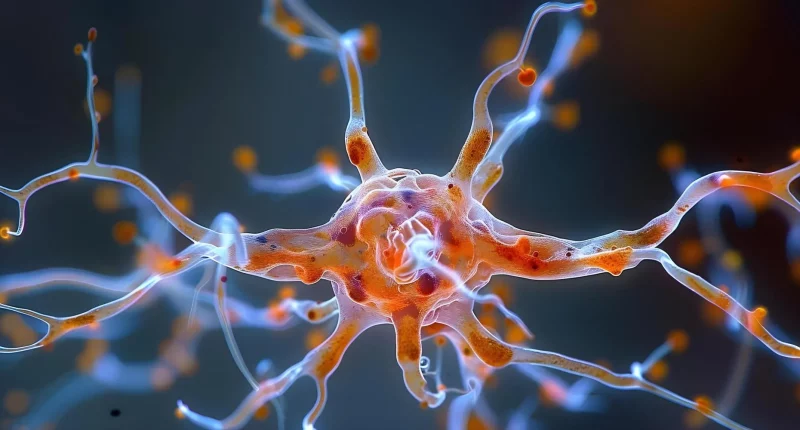Central pontine myelinolysis also known as CPM is an uncommon but serious condition that affects the brain and nervous system. In CPM, a substance called myelin, which acts as a protective cover for nerves, is damaged.
CPM usually occurs when healthcare providers correct low sodium levels in the blood too quickly. However, other factors can also lead to this condition.
What is it?
Central pontine myelinolysis is a condition that mainly affects the brainstem, particularly an area known as pons. This condition often causes significant damage to the brain and can impact functions related to hearing, taste, and movement. In severe cases, CPM can be fatal.
The crucial role is played by pons in regulating movement, taste, and hearing. When CPM occurs, it leads to serious damage to the myelin sheaths surrounding the nerves in this area. Myelin is important for appropriate nerve function, and its loss disturbs the transmission of nerve signals.
CPM is a component of a broader condition known as osmotic demyelination syndrome in short form ODS. It can also lead to the destruction of myelin in other areas of the brain, this process is referred to as extrapontine myelinolysis. Some individuals with CPM may get EPM simultaneously, while others may face only one of these conditions.
According to a review in 2019, CPM affects approximately 40 to 56% of individuals with ODS, while EPM is observed in 13 to 35% of those with ODS. Additionally, both conditions happen together in 23 to 31% of individuals with the syndrome.
Symptoms
CPM can significantly impact cognition, that is the ability to think and process information, as well as complete health. Sigs of CPM may begin to appear within two to three days or one to two weeks after a rapid correction of low sodium or electrolyte imbalances.
Common symptoms include decreased awareness and difficulties with speech. Individuals may experience dysphagia, which is trouble swallowing, and a decreased ability to fulfill thought processes. Muscle paralysis or weakness, particularly in the hands and legs, is also common, along with stiffness and a diminished ability to perceive the outside world. Coordination problems and tremors are additional symptoms that can affect daily functioning.
Complications
Many cases of central pontine myelinolysis can result in serious outcomes. One potential complication is locked-in syndrome, where individuals lose all body movement except for eye movements. Other severe complications include coma and death.
In addition to these severe outcomes, CPM can lead to other complications like venous thromboembolism, which involves blood clots forming in veins, and pneumonia. Patients might also become dependent on a respirator to help with breathing, experience muscle breakdown, develop UTIs, or suffer from decubitus ulcers, also known as pressure ulcers or bedsores.
Despite the seriousness of CPM, the mortality rate has decreased over time. A 2023 review indicates that approximately 94% of individuals alongside CPM survive. Of those survivors, 25 to 40% might get well without significant long-term cognitive effects. However, certain factors can heighten the risk of difficulties, including low potassium levels, low blood sodium, a low grade on the Glasgow Coma Scale, which checks how aware a person is while in a coma, and having recently had liver transplantation.
Causes
Central pontine myelinolysis most commonly arises when low sodium levels are corrected too sharply or rapidly. Hyponatremia, or low sodium, can result from an excess of water in the body, that dilutes the sodium concentration in the blood. This condition can be caused by several factors, including vomiting and diarrhea, kidney failure, the use of particular medications such as antidepressants, diuretics, or pain relief medicines, extreme thirst, and heart arrest.
The exact reasons why rapid correction of low sodium damages myelin is not fully understood. The brain has mechanisms to regulate sodium levels, and overcorrecting can disrupt this balance, potentially increasing the risk of CPM by forcing electrolyte levels too distant in the opposite direction.
During episodes of low sodium, cells of the brain may absorb excess water from their surroundings, leading to brain swelling. To counteract this, water might carry from the cells into the cerebrospinal fluid, which helps protect, nourish, and rule out waste from the brain. Additionally, osmolytes, molecules that help decrease swelling, are also lost along with the water. If sodium is corrected too rapidly, the brain cannot replenish these osmolytes, leading to dehydration of the brain tissue and damage to myelin. The exact mechanism of this damage remains unclear.
Risk Factors
Certain factors can increase the risk of developing central pontine myelinolysis. Individuals who have chronically low levels of sodium are at an increased risk, but CPM can potentially affect anyone.
The condition can also arise due to various other health issues. Risk factors include alcohol use disorder, malnutrition, chronic liver disease, and kidney disease. Additionally, heavy vomiting and loss of weight during the gestation period, known as hyperemesis gravidarum, can contribute to the development of CPM. The condition may also happen following other imbalances, like high blood sugar levels.
A review in 2019 indicates that CPM accounts for about 0.06 percent of hospital admissions. But this percentage increases significantly for individuals at increased risk, rising to 9.5 percent for those with known risk factors and 9.8 to 29 percent for individuals who have undergone a liver transplantation
Diagnosis
To diagnose extrapontine myelinolysis, healthcare providers typically use two main types of tests: one is blood tests and another one is MRI scans.
Blood tests are used to check sodium levels in the body. They assist healthcare providers in determining if sodium has been corrected too rapidly, which can be a sign of EPM.
An MRI scan, on the other hand, creates detailed images of the brain, including the pons, which are the areas of the brain most affected by EPM. This scan can show if there has been any damage. However, while MRI scans are useful, they are not always required for diagnosis. This is because the seriousness of the disorder and the time it takes to get MRI outcomes can sometimes make the test less immediate in confirming the diagnosis.
Treatment
There is no specific treatment to directly repair the myelin damage caused by central pontine myelinolysis. Instead, the focus is on supportive treatments to enhance comfort and improve standard of life. These supportive treatments can involve:
- Intensive physiotherapy to help maintain or restore mobility and decrease stiffness.
- Ventilator support to assist with breathing if needed.
- Anti-parkinsonism medications to help manage tremors.
- Rehabilitation to aid in regaining daily functional abilities.
Preventing CPM is the most effective approach. Healthcare providers monitor sodium levels in the blood, measured in milliequivalents per liter. A sodium level below 136 milliequivalents per liter is considered low. Treatment for this condition includes administering sodium through an intravenous infusion. However, it’s crucial to correct sodium levels gradually to avoid further complications.
Present guidelines suggest that sodium levels should be increased by no greater than 8 to 12 milliequivalents per liter over one day. If the cause of low sodium is unknown and it has persisted for two days or more, the increase should be limited to 6 to 8 milliequivalents per liter. For individuals with serious hyponatremia, where sodium levels are below 120 milliequivalents per liter, healthcare providers should reassess the IV sodium levels every hour. Additionally, a medication called desmopressin can help decrease the chance of sodium overcorrection throughout treatment.
Summary
Central pontine myelinolysis is a serious condition that affects the brainstem, particularly the pons, and can result in severe cognitive and physical symptoms. It often develops when low sodium levels are corrected too rapidly, but can also arise from other health issues. Diagnosis typically involves blood tests to check sodium levels and MRI scans to assess brain damage, though MRI may not always be necessary. Treatment focuses on supportive care, such as respirator support, physiotherapy, and rehabilitation. Preventing CPM involves carefully managing sodium levels, with guidelines recommending gradual correction. Desmopressin can help reduce the risk of complications during treatment.








